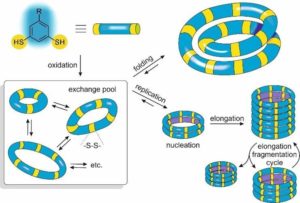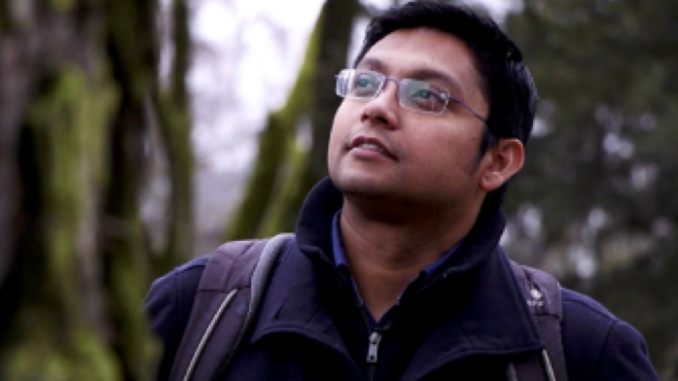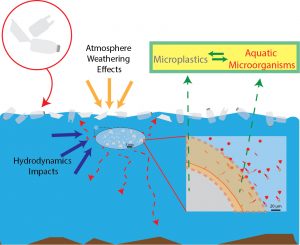DTU Active Annual Meeting
Monday, October 16, Campus Limpertsberg
Schedule:

Monday, October 16, Campus Limpertsberg
Schedule:
Wednesday, October 4 at 1:00 pm, Campus Limpertsberg
Abstract: How the immense complexity of living organisms has arisen is one of the most intriguing questions in contemporary science. We have started to explore experimentally how organization and function can emerge from complex molecular networks in aqueous solution. We focus on networks of molecules that can interconvert, to give mixtures that can change their composition in response to external or internal stimuli. Noncovalent interactions within molecules in such mixtures can lead to the formation of foldamers. In contrast, molecular recognition between molecules in such mixtures leads to their mutual stabilization, which drives the synthesis of more of the privileged structures . As the assembly process drives the synthesis of the very molecules that assemble, the resulting materials can be considered to be self-synthesizing. Intriguingly, in this process the assembling molecules are replicating themselves, where replication is driven by self-recognition of these molecules in the dynamic network. The selection rules that dictate which (if any) replicator will emerge from such networks are starting to become clear.

We have also witnessed spontaneous differentiation (a process akin to speciation as it occurs in biology) in a system made from a mixture of two building blocks. When such systems are operated under far from-equilibrium flow conditions, adaptation of the replicators to a changing environment can occur. Replicators that are able to catalyse reactions other than their own formation have also been obtained, representing a first step towards metabolism. Thus, the prospect of Darwinian evolution of purely synthetic molecules is tantalizingly close and the prospect of synthesizing life de-novo is becoming increasingly realistic.
About: The COVAMINF workshop, funded by the Joint Programme on Neurodegenerative Disease Research, is intended to bring together a wide multidisciplinary community to discuss links between Coronavirus, Amyloid Disease, and Inflammatory Disease. Medical practitioners, scientists of all fields, and those interested in health, environmental, and social policy are all welcome. See for more details.
About: Active matter is a category that includes systems with many self-propelled particles. They range from bacteria to bird flocks, as well as robot swarms, pedestrian or vehicular traffic. The fact that there is an energy expenditure makes this out-of-equilibrium matter an intriguing case to be studied with the tools of statistical physics. In this framework, familiar concepts such as flocking or clogging may be described as phase transitions. Computer models (although simple and rude sometimes) are helpful to understand some phenomena; in particular, the Vicsek model for flocking, the Nagel-Schreckenberg model for vehicular traffic and the Helbing model for pedestrian dynamics will be considered. Robot swarms also belong in the realm of active matter, and they are often a good choice to perform simple experiments.

Published on Thursday, 12 November 2020
In the context of their forthcoming strategy plan, EMBL wants to develop and venture into theoretical biology much more than in the past and have defined “Theory” as one of their strategic areas. To jump-start these activities, they have launched a fellowship call for visitors that would come and work with an experimental group at EMBL. See more details. The next deadline is 31st of December.
Short description:
EMBL aims to create a new and highly integrated Theory programme to complement EMBL’s research and data-driven approaches to studying life in context. The complexity of biology necessitates theoretical approaches. This design will build up approaches from first principles and will explain biological phenomena using mathematical formalism and models, turn data into understanding, and generate testable predictions. Theoretical approaches will be developed and applied to answer specific questions from all six research themes. The interplay between theoretical and experimental research, complemented by a theoretical training programme and visiting theoreticians, will be an integral requirement for achieving EMBL’s scientific goals.
Published on Tuesday, 15 September 2020, Original Text

We are thrilled to announce Anupam Sengupta as a speaker at the TEDxUniversityofLuxembourg 2020. He will explain “Why microbes are crucial in tackling the climate crisis?”
“Microbes are our modern currency. The currency that could hold the human-nature balance sheets in order, as we nosedive into a climatic recession!”
Anupam Sengupta is an ATTRACT Fellow and Professor of Biological Physics at the University of Luxembourg. He directs a cross-disciplinary team of scientists working on emergent behaviour and functions in biological systems. Understanding how anthropogenic activities impact microorganisms, and tend to derail delicate biophysical processes, is at the heart of Anupam’s research. He is an enthusiastic educator and regularly makes time to interact with younger minds. For his contributions to science, Anupam has received multiple international recognitions, including his selection as Promising Young Scientist for the Future at the 2015 Lindau Meeting for Nobel Laureates.
Watch this video: https://www.youtube.com/watch?v=F0ibLGXBuoA or follow the link to find out more about Anupam’s research: https://sengupta.mit.edu
For more details on this event: TEDx University of Luxembourg
Published on Tuesday, 15 September 2020, Original Text

We are thrilled to announce Anupam Sengupta as a speaker at the TEDxUniversityofLuxembourg 2020. He will explain “Why microbes are crucial in tackling the climate crisis?”
“Microbes are our modern currency. The currency that could hold the human-nature balance sheets in order, as we nosedive into a climatic recession!”
Anupam Sengupta is an ATTRACT Fellow and Professor of Biological Physics at the University of Luxembourg. He directs a cross-disciplinary team of scientists working on emergent behaviour and functions in biological systems. Understanding how anthropogenic activities impact microorganisms, and tend to derail delicate biophysical processes, is at the heart of Anupam’s research. He is an enthusiastic educator and regularly makes time to interact with younger minds. For his contributions to science, Anupam has received multiple international recognitions, including his selection as Promising Young Scientist for the Future at the 2015 Lindau Meeting for Nobel Laureates.
Watch this video: https://www.youtube.com/watch?v=F0ibLGXBuoA or follow the link to find out more about Anupam’s research: https://sengupta.mit.edu
For more details on this event: TEDx University of Luxembourg
Published on Tuesday, 15 September 2020, Original Text

We are thrilled to announce Anupam Sengupta as a speaker at the TEDxUniversityofLuxembourg 2020. He will explain “Why microbes are crucial in tackling the climate crisis?”
“Microbes are our modern currency. The currency that could hold the human-nature balance sheets in order, as we nosedive into a climatic recession!”
Anupam Sengupta is an ATTRACT Fellow and Professor of Biological Physics at the University of Luxembourg. He directs a cross-disciplinary team of scientists working on emergent behaviour and functions in biological systems. Understanding how anthropogenic activities impact microorganisms, and tend to derail delicate biophysical processes, is at the heart of Anupam’s research. He is an enthusiastic educator and regularly makes time to interact with younger minds. For his contributions to science, Anupam has received multiple international recognitions, including his selection as Promising Young Scientist for the Future at the 2015 Lindau Meeting for Nobel Laureates.
Watch this video: https://www.youtube.com/watch?v=F0ibLGXBuoA or follow the link to find out more about Anupam’s research: https://sengupta.mit.edu
For more details on this event: TEDx University of Luxembourg
Published on Friday, 28 February 2020
Irvine Ong, postdoctoral researcher within the Department of Physics and Materials Science at the University of Luxembourg has been recently awarded the Marie Curie Individual Fellowship from the European Commission. With a budget of 178 320 euros for two years, Irvine will work on microplastic-microbe interactions.

Native of Singapore, Dr. Irvine Ong started his postdoctoral research in September 2019, at the Physics of Living Matter Group. Prior to joining Prof. Anupam Sengupta’s lab, Irvine received his PhD from the National University of Singapore (NUS) in 2016, followed by a short stint at an NUS-based startup, and then in February 2018, Irvine moved to the École Polytechnique Fédérale de Lausanne (EPFL, Switzerland) for his first postdoctoral research. In summer 2019, Irvine teamed up with Prof. Sengupta to put his broad scientific interests – ranging from biosensing based on liquid crystals to applied microfluidics for medical processes – into concrete plans. With a strong appreciation and interest in addressing fundamental questions of direct socio-environmental relevance, Irvine took a leap into biophysics by starting to look at the interactions between microplastics and microorganisms.

Combined with Sengupta Lab’s expertise in innovating micro-scale biophysical approaches, Irvine has been granted the Marie Skłodowska-Curie Actions –Individual Fellowship (MSCA-IF) for the project BIOMIMIC. Through BIOMIMIC (BIOphysics of MIcrobe-Microplastic Interactions & Colonization), Irvine will build a highly multi-disciplinary approach to tease apart the intricate and dynamic relationships between microplastics – micro-scale pollutants teeming our biosphere – and microorganisms, all within the Group’s ocean-mimicking experimental set ups. Irvine hopes that ultimately his research will propel sustainable bioremediation solution for this yet-to-be-addressed issue. Given the vital role of microbes in maintaining the bio-geo-chemical cycles, the goal of Irvine’s MSCA-IF is to delineate the mechanistic underpinnings of one of the biggest environmental issues of the present day. “It’s a challenging project – that spans multiple scales and disciplines – however with the expertise in Sengupta Lab, and the support of a vibrant cross-disciplinary research ecosystem in Luxembourg, I am confident of breakthroughs in this highly innovative project”, says Irivine.
Published on Friday, 22 Novenber 2019

Physicists from the University of Luxembourg and their international research partners have reported a comprehensive perspective on how novel nanoscale tools called plasmonic nanopores might improve in an unprecedented manner the way we can discriminate single-molecule DNA bases, and even identify single proteins components, that is amino acids, coming from specific patients.
The scientists have published a Mini Review in Nano Letters, the prestigious journal of the American Chemical Society reporting the latest and most breakthrough advances of fundamental research in all branches of the theory and practice of nanoscience and nanotechnology. The article was produced in cooperation with researchers at Northeastern University in Boston (US) and the Italian Institute of Technology (Italy).
The human proteome is the whole set of proteins that a human can express. Most of the human proteome is known. In fact, along the years, bio-informatics reconstructed the human proteome by correlating different databases coming from mass spectrometry, genome analyses, and other techniques. However the proteome, being the set of proteins potentially expressed, does not give information regarding the protein really expressed in a specific person or a patient, which own a specificity as due to post-translational modifications and alternative splicing. “To access this fundamental information is necessary to develop new and even more sensitive techniques for single protein identification able to work with small samples and low molecular concentration,” explains Nicolò Maccaferri, Researcher in the Ultrafast Phenomena in Condensed Matter Group led by Prof. Daniele Brida at the Department of Physics and Materials Science at the University of Luxembourg.
Solid-state nanopore-based sensors are promising platforms for next-generation sequencing technologies, featuring label-free single-molecule sensitivity, rapid detection, and low-cost manufacturing. In recent years, solid-state nanopores have been explored due to their miscellaneous fabrication methods and their use in a wide range of sensing applications.
“We focus on a novel family of solid-state nanopores which have recently appeared, namely plasmonic nanopores. The use of plasmonic nanopores to engineer electro-magnetic fields around a nanopore sensor allows for enhanced optical spectroscopies, local control over temperature, thermophoresis of molecules and ions to/from the sensor, and trapping of entities,” explains Maccaferri.
In order to achieve this result, the scientists design and synthetise these nano-pores which exploit surface plasmon resonances (SPRs), the collective oscillations of the conduction electrons in metallic nanostructures. These nanoscale objects have found applications in several fields such as light harvesting, photocatalysis, subwavelength imaging, metamaterials, and nanomedicine. Among others, one specific family of plasmonic platforms is based on plasmonic nanohole arrays and the more recently implemented plasmonic nanopores, sub-100 nm apertures connecting two compartments, for sensing applications. Plasmonic-based solid-state nanopore sensors present new opportunities for biomolecular sensing.
In fact, a plasmonic nanostructure can enhance and focus electro-magnetic radiation to a nanoscale volume (hotspot) localised at the nanopore, in which biomolecules can be “scanned” as they translocate through the pore. “This approach is very powerful for the following reasons because the measurement is independent from electrical sensing as in commercially available biological or solid-state nano-pore bio-sensors, and relies on detection of photons rather than electrons. Moreover the optical detection can be performed in the far-field, as photons freely travel in the aqueous media surrounding the nano-pores,” says Maccaferri, who is now dreaming to build a team of scientists here in Luxembourg working on this topic by using light-based nanotechnologies. “It would be wonderful to have a multi-disciplinary working group of physicists, chemists, biologists and, in the future, even companies and hospitals interested in implementing this promising technology to bring it to the market to have an affordable sensing platform which can be used at patients’ homes.”
“Since my arrival at the University, I realised that Luxembourg can be a great place to bring forward visionary ideas. I hope we can start an activity where we combine our experimental knowledge on light-matter interactions and the huge amount of possibilities offered by this University, which is investing a lot of efforts in harnessing biology and physics (https://cls.uni.lu/)” concludes Maccaferri, who is very excited about the new stimulating challenges offered by this topic.
Publication: “Plasmonic Nanopores for Single-Molecule Detection and Manipulation: Toward Sequencing Applications“, Nano Letters, October 2019
Published on Monday, 21 October 2019
 Physicists at the University of Luxembourg have developed theoretical tools to analyse and optimise chemical engines ranging from simple chemical reaction networks to complex metabolic pathways.
Physicists at the University of Luxembourg have developed theoretical tools to analyse and optimise chemical engines ranging from simple chemical reaction networks to complex metabolic pathways.
The paper “Thermodynamic efficiency in dissipative chemistry,” collects the result of the research conducted by Prof. Massimiliano Esposito, Dr. Riccardo Rao and PhD student Emanuele Penocchio from the Faculty of Science, Technology and Communication at the University of Luxembourg. It was published in the prestigious journal Nature Communications.
Thermodynamics – the branch of physics dealing with energy conversion and its limitations – originated in an effort to improve the efficiency of mechanical engines, such as steam or combustion engines. In standard theory, thermodynamic laws were never applicable to characterising the performance of small chemical engines, such as living cells.
In mechanical engines, maximum efficiency never coincides with maximum power. A car’s efficiency varies depending on the speed. If driven fast at full horsepower, the efficiency at maximum power is usually very low.
Things can be different in the world of molecules as Prof. Esposito, Dr. Rao and Mr. Penocchio have discovered. The researchers have developed a new method to apply principles of thermodynamics to chemical systems. These findings may prove to be helpful in bioengineering or nanotechnology in the future.
The research has taken a step towards evaluating the thermodynamic cost to build and keep a cell working. For example: How much energy in the food consumed by a cell is wasted and how much is used on the chemical level? The results record conditions in which systems work at maximum efficiency and maximum power simultaneously.
“We usually assume that nature is very efficient thanks to ages of evolution. By quantifying the efficiencies of various chemical operations in different organisms, we may be able to put those kinds of ideas on more solid ground one day, thus contributing to a better understanding of biological systems. This study provides the basis for future performance studies and optimal design in chemistry. We can now answer questions about the efficiency of any operation done by an open chemical system,” Prof. Esposito states.
To find out more read the freely accessible paper on Nature Communications. Image: Michela Bernini and Mitch Woodensteel. See the original article from University of Luxembourg
September 2019, Communication from LCSB Team
 Soon some members from the Department of Physics and Materials Science will regularly visit BT1 (LCSB buiding): Prof. Anupam SENGUPTA and his team are moving in to build bridges between physics and biology. In this “Coffee with”, he is telling us more about his background, the focus of the research group and the partnership with the LCSB. Read more…
Soon some members from the Department of Physics and Materials Science will regularly visit BT1 (LCSB buiding): Prof. Anupam SENGUPTA and his team are moving in to build bridges between physics and biology. In this “Coffee with”, he is telling us more about his background, the focus of the research group and the partnership with the LCSB. Read more…
August 2019, Nature communications
Prof. Massimiliano Esposito and Emanuele Penocchio, a PhD student who participated in the paper have elaborated a rigorous theoretical method to analyse and optimise chemical engines, from simple chemical reaction networks to complex metabolic pathways.The paper entitled “Thermodynamic efficiency in dissipative chemistry” is built on the results of many years of research by the group “Complex Systems and Statistical Mechanics” led by Prof. Massimiliano Esposito at the University of Luxembourg. Read more…
The editors at Nature Communications have chosen to feature this article on the Editors’ Highlights webpage of recent research on Inorganic, Nanoscale and Physical Chemistry and is linked prominently on Nature communications homepage.
A “behind the paper” post for the Nature Research Chemistry Community blog has also been published. Read more…
Artistic interpretation of this research from Michela Bernini and Mitch Woodensteel:

January 11, 2019 – Physics 12
Two Physicists are on the hunt for a “theory of life” that explains why life can exist. Read more
Organisms have aspects of both complexity and order, as in this slice of a plant stem.
Researchers hope to eventually develop basic equations that describe all of life.